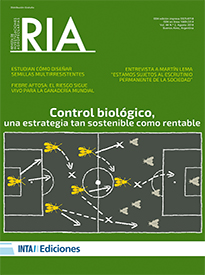Ver ítem
- xmlui.general.dspace_homeDirección Nacional y DNAsSistemas de Información, Comunicación y CalidadGerencia de Comunicación e Imagen InstitucionalArtículos científicosxmlui.ArtifactBrowser.ItemViewer.trail
- Inicio
- Dirección Nacional y DNAs
- Sistemas de Información, Comunicación y Calidad
- Gerencia de Comunicación e Imagen Institucional
- Artículos científicos
- Ver ítem
Análisis de diferentes secuencias de cultivos: aportes al sistema productivo
Resumen
Los objetivos del trabajo fueron: i) evaluar la producción de biomasa y el rendimiento de distintas secuencias de cultivos de cuatro años de duración (S1: trigo/soja 2.º –maíz–soja–trigo; S2: cebada/soja 2.º–maíz–soja–trigo; S3: avena/soja 2.º –maíz–girasol–trigo y S4: colza/soja 2.º –maíz–sorgo–trigo) bajo dos manejos tecnológicos: nivel medio (NTM: manejo del productor promedio) y nivel alto (NTA: manejo del productor de punta), ii) evaluar la
[ver mas...]
Los objetivos del trabajo fueron: i) evaluar la producción de biomasa y el rendimiento de distintas secuencias de cultivos de cuatro años de duración (S1: trigo/soja 2.º –maíz–soja–trigo; S2: cebada/soja 2.º–maíz–soja–trigo; S3: avena/soja 2.º –maíz–girasol–trigo y S4: colza/soja 2.º –maíz–sorgo–trigo) bajo dos manejos tecnológicos: nivel medio (NTM: manejo del productor promedio) y nivel alto (NTA: manejo del productor de punta), ii) evaluar la extracción de nitrógeno (N), fósforo (P), azufre (S) y potasio (K) y el balance de N y P para cada secuencia completa. Los ensayos se llevaron a cabo en la Estación Experimental J. Hirschhorn (Los Hornos), dependiente de la Universidad Nacional de La Plata. El diseño experimental fue en bloques al azar con cuatro repeticiones y en parcelas divididas. Se usó la prueba de Tukey para la comparación de medias (P<0,05). La biomasa total tendió a ser mayor en S2, que a su vez presentó el mayor rendimiento total en grano (32212 kg ha-1). La fecha de cosecha del cultivo antecesor, como el volumen y calidad de su rastrojo modificaron la respuesta del cultivo sucesor. El mayor aporte de nutrientes en el NTA hizo que la biomasa total y los rendimientos fueran superiores, con una diferencia con respecto al NTM de 4715 y 1865 kg ha-1, respectivamente, aumentando así la extracción de nutrientes. Las mayores extracciones de N se dieron en S2 y S1, que además de sus elevados rendimientos, incluyeron a la soja con mayor frecuencia, y en S4 con el cultivo de colza. Las mayores extracciones de P y S se dieron en S4, seguida de S2, S1 y S3. Para el caso del K, las mayores extracciones se dieron en S2, seguida por S4, S1 y S3. Los balances de N y P resultaron negativos para todos los casos analizados. Los niveles de tecnología empleados en el presente trabajo, que son los que habitualmente realiza el productor de la zona, no alcanzan para satisfacer la capacidad extractiva de los cultivos y por ello resulta difícil esperar encontrar balances nulos en esta.
[Cerrar]
The objectives of the study were: i) evaluate the production of biomass and yield of different crop sequences, four years in length (S1: wheat /2nd soybean -corn-soybean-wheat; S2: barley /2nd soybean -corn-soybeanwheat; S3: oat/2nd soybean -corn-sunflower-wheat and S4: canola/2nd soybean -corn-sorghum-wheat) under two technological manipulations: average level (NTM: used by the average farmer) and high level (NTA used by the tip farmer), ii) evaluate
[ver mas...]
The objectives of the study were: i) evaluate the production of biomass and yield of different crop sequences, four years in length (S1: wheat /2nd soybean -corn-soybean-wheat; S2: barley /2nd soybean -corn-soybeanwheat; S3: oat/2nd soybean -corn-sunflower-wheat and S4: canola/2nd soybean -corn-sorghum-wheat) under two technological manipulations: average level (NTM: used by the average farmer) and high level (NTA used by the tip farmer), ii) evaluate Nitrogen (N), phosphorus (P), sulfur (S) and potassium (K) extraction and N and P balance, for each complete sequence. The trials were conducted at the Experimental J. Hirschhorn (Los Hor-nos) dependent of Universidad Nacional de La Plata. The experimental design was in random blocks with four replicates and in divided plots. The Tukey test was used for the comparison of means (P<0.05). Total biomass tended to generate higher volume in S2, which resulted in a higher total grain yield in that sequence (32212 kg ha-1). The harvest date of the predecessor crop, such as the volume and/or quality of the stubble left, modified the successor’s response. The greater contribution of nutrients in the NTA caused total biomass and yields to be higher with a difference of 4715 and 1865 kg ha-1, respectively, increasing the nutrient extraction. The highest extractions of N occurred in S2 and S1, which in addition to their high yields, included soybean with the highest frequency, and in S4 with rape crop and S3. The highest phosphorus and sulfur extractions occurred at S4 followed by S2, S1 and S3. For the case of potassium the largest extractions were given in S2, followed by S4, S1 and S3. The N and P balances were negative for all cases analyzed. The levels of technology used in this work, which are usually carried out by the farmer in the area, are not enough to satisfy the extractive capacity of the crops. Therefore it is difficult to expect to find zero balances in it.
[Cerrar]

Autor
Voisin, Axel Iván;
Novillo, Bárbara Victoria;
Chamorro, Adriana;
Bezus, Rodolfo;
Pellegrini, Andrea;
Golik, Silvina Inés;
Fuente
RIA 44 (2) : 105-112 (agosto 2018)
Fecha
2018-08
ISSN
0325-8718
1669-2314
1669-2314
Formato
pdf
Tipo de documento
artículo
Palabras Claves
Derechos de acceso
Abierto
 Excepto donde se diga explicitamente, este item se publica bajo la siguiente descripción: Creative Commons Attribution-NonCommercial-ShareAlike 2.5 Unported (CC BY-NC-SA 2.5)
Excepto donde se diga explicitamente, este item se publica bajo la siguiente descripción: Creative Commons Attribution-NonCommercial-ShareAlike 2.5 Unported (CC BY-NC-SA 2.5)


